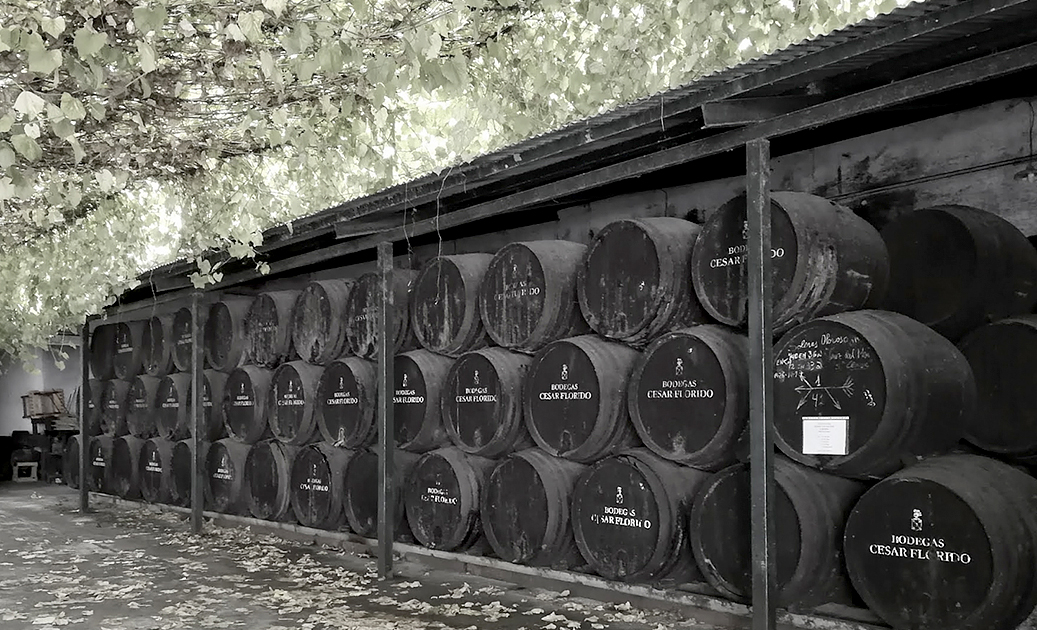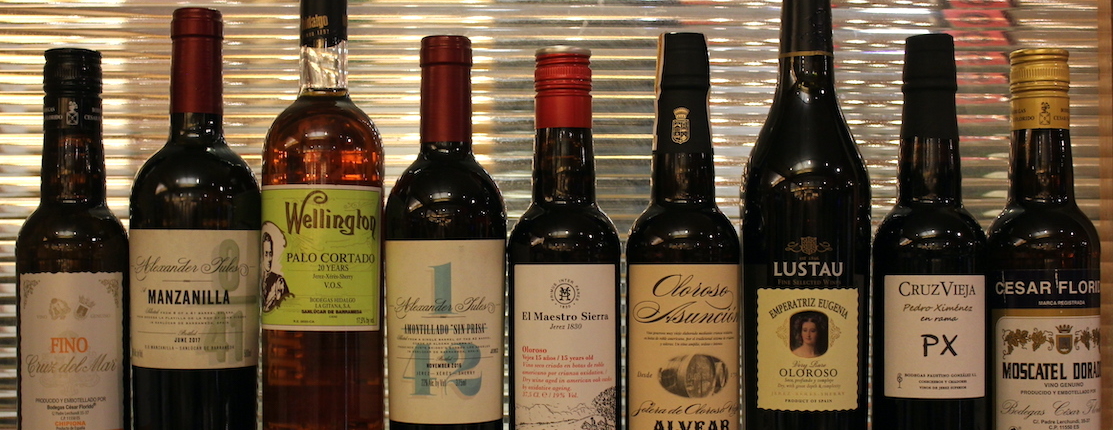Sometimes, there’s just no convincing the people. Though sherry is a relatively recent discovery for me, I’ve been singing its praises for more than a decade–with little success. I hear all the familiar refrains: “My grandmother used to love her $6 sherry,” or “Who are you, Frasier Crane?” That’s fine–more for me.

A solera at Bodegas César Florido
Made primarily from the palomino grape, grown on a chalky, limestone-laden type of soil known as “albariza,” sherry is an incredibly versatile and nuanced type of wine. Its homeland is Jerez (hence the name sherry), located on the Atlantic coast in Spain’s southwestern Andalusia region. Sherry can be mellow and easygoing, sharp and bracing, and everything in between. Some are as friendly and relaxed as an old dog; some have enough power and intensity to send ol’ grandma into cardiac arrest.
Sherry is produced using what’s known as a solera system, in which barrels are stacked in tiers to allow for fractional, cross-vintage blending. When the older stuff at the bottom is removed for bottling (a process called the “saca”), it is replaced at the top by the latest vintage.
The lightest, driest, and tangiest sherries are fino and manzanilla, which spend their aging regimen under a layer of yeast known as “flor” (a process known as biological aging). Amontillado and palo cortado begin life as a fino or manzanilla, but are allowed to oxidize after the yeast dies or is killed off by fortification–a combination of biological and oxidative aging– imparting a nuttier, more caramel-like tone while still retaining tang and freshness. Oloroso sherries are fully oxidative (no yeast) and are rich with toffee and dried fruit flavors, yet still mostly dry. Finally, there are sweet sherries made with grapes such as Pedro Ximénez (PX) and moscatel.
The three poles of the Sherry Triangle are Sanlúcar de Barrameda to the north (home to manzanilla), Jerez de la Frontera to the east, and El Puerto de Santa Maria to the south. At Paul Marcus Wines, we are proud to feature sherry producers from throughout the region (and even a couple that are technically outside the triangle).
Up in Sanlúcar, the venerable Bodegas Hidalgo-La Gitana has been making sherry since the 18th century. Their budget-friendly, young Amontillado Napoleon is bright and dry, with subtle hazelnut notes and a long, clean finish. For a special occasion, try the Amontillado Napoleon VORS, which is pungent, mouth-filling, and caramelized, yet still surprisingly focused and floral for a wine aged well more than 30 years. We also have the Wellington Palo Cortado VOS, a sophisticated 20-year sherry that, despite its age, never lets you forget it started out as a manzanilla–it’s sharp, salty, creamy, and nutty all at once, and a reasonably priced entry point into the world of high-end sherry.
Bodegas Faustino González was founded 50 years ago, but its Cruz Vieja line is a newcomer on the sherry scene. The winery is located in the San Miguel neighborhood of Jerez de la Frontera, where the higher elevation invites the Atlantic breezes in from the west. They source their grapes from the historic Pago de Montealegre vineyard, and they own soleras that date back nearly 250 years.
All of the Cruz Vieja sherries are bottled “en rama” (unfiltered), including a delightfully complex, persistent, and mineral Fino En Rama, aged under flor for six years, and a lightly toasted, elegant, amber-hued Amontillado En Rama, which spends six years under flor plus another six aging oxidatively. Their Palo Cortado En Rama spends only the first of its 12 aging years under the veil, but still exemplifies their lighter touch and commitment to freshness. For a completely different experience, their Pedro Ximénez En Rama is raisiny and sweet as molasses, yet is also highlighted by a few spicy, savory notes. Pour this one over a bowl of vanilla ice cream.
Around since 1896, Bodegas Lustau remains one of the best-known and most-respected sherry producers in the world, offering a wide selection of bottlings. At PMW, we offer two from their Almacenista collection–sherries that come from small, independent producers. The Fino del Puerto González Obregón is a salty, citrusy, and edgy five-year fino from a bodega in El Puerto de Santa Maria, while the Oloroso Emperatriz Eugenia, from a solera in Jerez de la Frontera started by Emilio Lustau in 1921, is rich, woody, dark, and robust, ripe with dried fruit yet still mostly dry.
From El Maestro Sierra, which dates back to 1830, we offer a 15-year Oloroso, which balances its richness with a few higher-toned elements. We also have a few bottles left of some of El Maestro Sierra’s most prized releases: the 70-plus-year-old Palo Cortado and the Oloroso 1/14–wines of tremendous electricity and complexity. In addition, there are a couple of VORS (Very Old Rare Sherry, more or less) bottlings from Osborne, the Oloroso Sibarita and the Pedro Ximénez Venerable. Like the two high-end offerings from El Maestro Sierra, these offer unique, once-in-a-decade drinking experiences that will make you wonder how grape juice can be made to taste that way.

From outside the official Sherry Triangle, we have wines from Chipiona’s César Florido. Chipiona, located five miles west of Sanlúcar, is known for moscatel, a grape that produces sweet wines (though not to the level of PX) balanced with some acidity and gentle fruit and spice elements. Florido’s Moscatel Dorado is a great introduction, with its notes of orange peel and honey. Florido’s Fino Cruz del Mar is a three-year en rama fino that is quite dry, yeasty, and smoky–bright, but laid-back.
Bodegas Alvear can be found in Montilla, about two-and-a-half hours to the east of the Sherry Triangle. PX is king in Montilla-Moriles, and Alvear’s Oloroso Asunción is made with sugar-filled PX instead of palomino. Fermented into a welcoming off-dry style (19 percent alcohol, without any fortification), it combines sumptuous dried figs with a surprisingly lucid and lively finish.
Finally, PMW still has a few options from the Alexander Jules line. Alex Russan had been releasing his barrel-selected sherry since 2012, but recently moved on to other endeavors. Luckily, there are still a few bottles of his Amontillado Sin Prisa 1/42–all culled from a single barrel of a long-forgotten 42-barrel solera in Sanlúcar. Only 400 half-bottles were produced of this vigorous, dynamic, yet unexpectedly polished nectar.
With such an array of producers and styles, there’s a sherry that’s perfect for pretty much every part of the meal. As the old saying goes, “fino or manzanilla if it swims, amontillado if it flies, and oloroso if it runs.” Of course, it can be awfully rewarding as an aperitif or, especially, a digestif–a wine of reflection, if you will. Once you discover the wonders of sherry, trust me, you’ll be hooked.
Just don’t tell anyone else…
